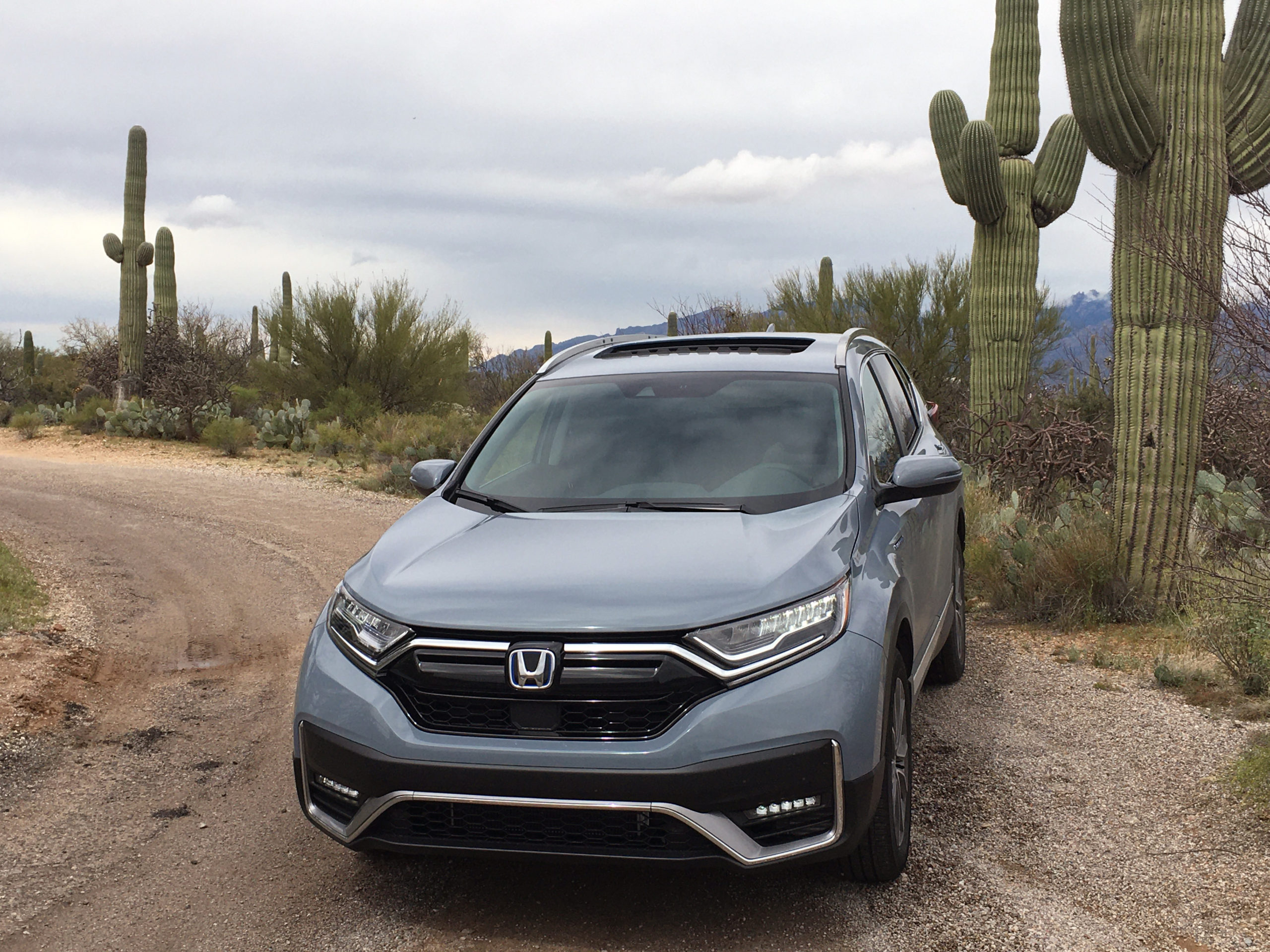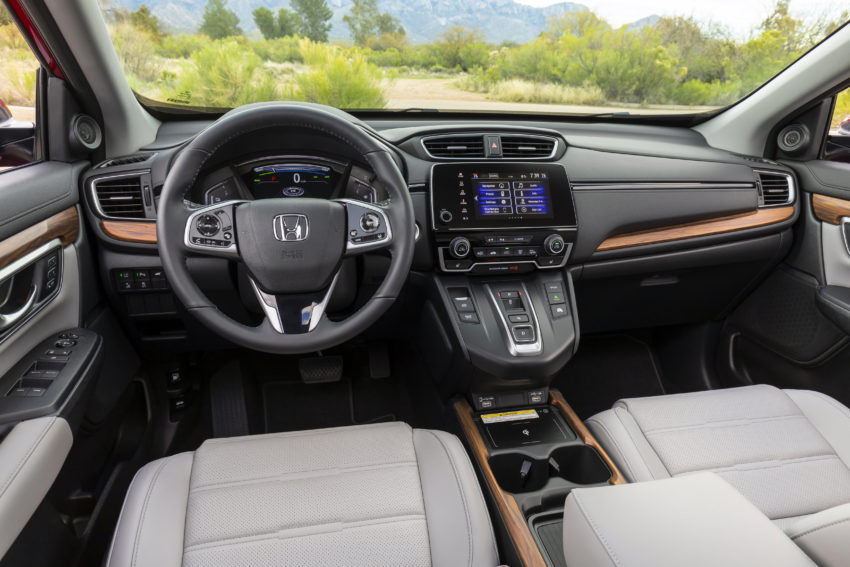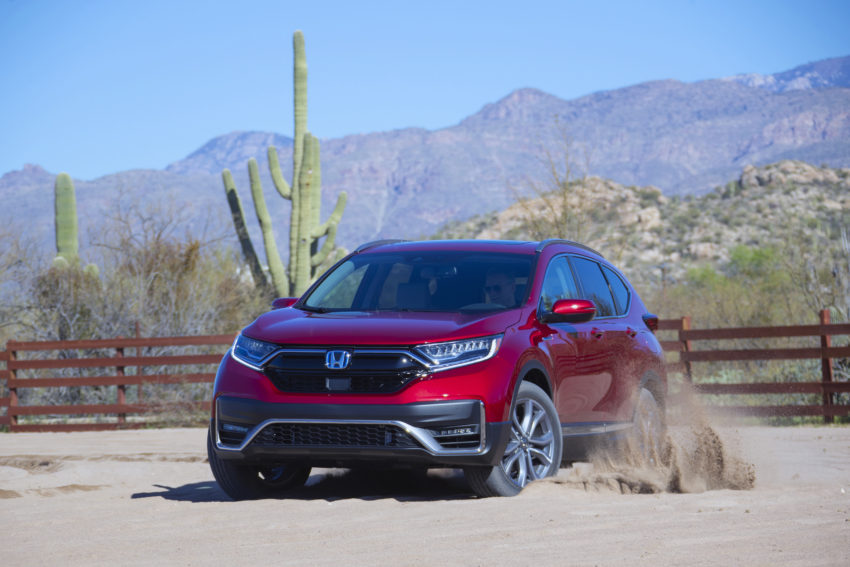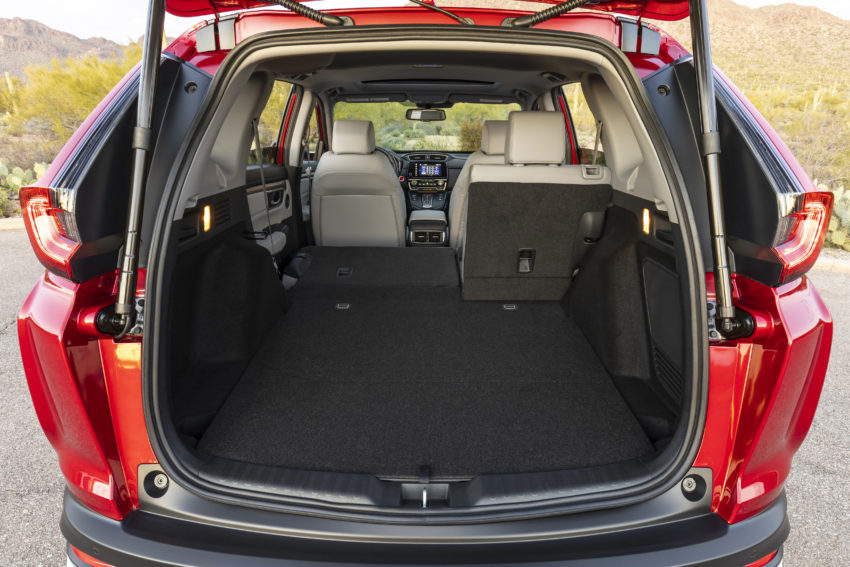
Honda chose to introduce the media to the 2020 CR-V Hybrid with a drive on flat city streets in and around Tucson, Az.
The company’s first hybrid SUV proved to be a pretty good ride. The route, however, did it no justice.
Honda doubtlessly planed it to showcase the CR-V Hybrid’s fuel efficiency. The compact crossover is EPA rated at 38 mpg combined but can do decidedly better than that on flat terrain with lots of stop-and-go so the regenerative braking system can keep the hybrid battery charged.
[Estimated Reading Time: 9 min., 30 sec.]
But city driving does little to show off a vehicle’s road manners, my driving partner and I agreed.
“This route is boring,” one of us said to the other – and the search was on.
Tucson is ringed by mountains and it didn’t take us long to find a nice twisty route from the Sonoran Desert floor to the top of one of the tallest surrounding peaks– the 9,159-foot Mt. Lemmon in the Santa Catalina Mountains.
Power, Handling, Etc.
While the regular CR-V uses a turbocharged 1.5-liter gas engine rated at 190 hp and 197 lb-ft of torque, the CR-V Hybrid uses a more powerful system that combines a normally aspirated 2.0-liter gas engine with two electric motors. The hybrid system is rated at a peak 212 hp and 232- lb-ft.
That makes it the most powerful CR-V ever and gave it plenty of oomph to handle the climb up Mt. Lemmon.
The mostly two-lane Sky Island Scenic Byway provides a twisty but well-surfaced, 27-mile asphalt path to the Mt. Lemmon ski area, where a rougher private road takes you another few miles to a parking lot at the 9,100-foot level, just below the mountain’s summit.
It was an overcast 66 degrees when we started the drive, and 32 degrees and slightly foggy with patches of snow on the ground when we hit the parking lot.
The CR-V Hybrid never felt underpowered or overwhelmed on the drive. Steering was solid and purposeful; the not-so-little anymore crossover went where it was pointed, even on the tightest hairpins, with minimal body roll or sway.
The suspension setup maintains a nice balance between ride comfort and competent handling; the cabin is well-insulated against road noise and the leather-clad seats in the top-of-the-line Touring model we were assigned were comfortable and supportive.
The only disconcerting note was the engine’s song: The CR-V Hybrid is designed as a series-parallel hybrid with heavy emphasis on electric drive. It uses the gas engine as a generator most of the time.
When you are stomping on the accelerator to maintain or increase speed on a steep uphill climb, the engine works harder than the indicated speed would seem to require. That’s because the electric motor is demanding a lot of juice.
On the way down, however, the engine hardly works and there’s almost no noise.
Overall, acceleration is smooth – there’s no transmission because the electric motors regulate the flow of torque to the wheels. And while the CR-V Hybrid won’t win the pole in many races, it is quicker than the gas-only version and packs plenty of power to get you onto the highway and let you keep up with the pack – even lead it if you’d like.

Competition in the small non-luxury hybrid crossover class is limited. With the demise this year of the Nissan Rogue Hybrid, the only all-wheel drive compact crossovers with gas-electric powertrains are the CR-V, Toyota RAV4 and the Ford Escape.
All three are close in features, pricing and performance – a wise shopper would look at all three and likely couldn’t go wrong whatever the choice. The Honda gets points for its smooth ride and refined good looks. Styling – the Honda and Ford share conventional SUV looks while the RAV 4 tries for sporty with lots of angles and creases – and individual tastes and brand preference are likely to be the deciding factor in most cases.
Three Settings
In normal daily driving, the CR-V Hybrid’s computer decides whether it is most efficient to use battery- power for low-speed all-electric driving; electric power from the engine, working as a generator, or power from the gas engine funneled directly to the front wheels.
But Honda provided a trio of drive mode buttons so the driver can exert a little control. EV forces the CR-V Hybrid into all-electric mode at low speeds for up to a mile when the small hybrid battery is sufficiently charged. Econ slows down accelerator pedal response to maximize fuel efficiency. Sport increases throttle response for more spirited acceleration.
The CR-V Hybrid also has wheel-mounted “shift” paddles that dial in varying degrees of regenerative brake force, allowing the driver to use the system to slow the crossover without using the manual brakes. It’s not a one-pedal system though. The brake pedal has to be engaged to bring things to a complete stop.
Fuel Economy
The EPA rates the 2020 CR-V Hybrid at 40 mpg in city diving, 35 mpg on the highway and 38 mpg overall. That’s 2 mpg less than the competition.
The 2020 RAV4 Hybrid and 2020 Ford Escape Hybrid with all-wheel drive–the only other compact hybrid crossovers in the non-luxury segment – both are rated at 40 mpg combined.
The EPA says the Toyota should get up to 41 mpg in the city and 38 mpg on the highway while the Ford is rated at 43 mpg city and 37 mpg highway.
In reality, it’s hard for many divers to achieve EPA efficiency. Most of us drive too much and too fast on the highways, with the AC blasting in the warmer months. The EPA’s five-cycle test is biased toward city driving – 55 percent versus 45 percent on the highway – and air conditioning is used during only one low-speed cycle.
In our day with the 2020 CR-V Hybrid, with climate control set to maintain a balmy 69 degrees, we averaged 40.2 mpg during the 55-mile city drive to the Tanque Verde dude ranch from our hotel in Tucson. We recorded 33.2 mpg for the 81 miles from the dude ranch up Mt. Lemmon and back down to our hotel.
For the 27-mile trip up the mountain – and we were pushing it hard – the CR-V Hybrid averaged just over 20 mpg. On the 39.2-mile trip down the mountain and back to our hotel (by a much shorter route than the trip out), it averaged 90.3 mpg.
Honda’s First Hybrid AWD
The 2020 CR-V Hybrid uses a powertrain that’s new to the CR-V family but not to Honda. It is an all-wheel drive sibling of the two-motor hybrid introduced on the 2018 Accord Hybrid.
To make a passenger car propulsion system meaningful in a crossover, Honda combined it with an electronically controlled version of the all-wheel drive system that’s an option on gas-only CR-V models.

All 2020 CR-V Hybrids get the AWD system as standard equipment. It sends up to 40 percent of available torque to the rear wheels when the need for traction back there is detected by the CR-V’s sensors. It won’t apportion torque – called torque vectoring – between the rear wheels, however. Each gets the same amount of power no matter what.
On a short figure-8 course Honda set up in sand-filled rodeo ring at Tanque Verde Ranch, the system proved itself to be capable, quiet and not quite so overly controlled as the AWD system that comes standard on the CR-V Hybrid’s direct competitor, the RAV4 Hybrid. TheGreenCarGuy hasn’t yet tested the Escape Hybrid.
(Full disclosure: TheGreenCarGuy owns a 2019 RAV4 Hybrid.)
Smoother, Quieter
Honda provided a RAV4 Hybrid Limited for comparison drives and its all-wheel drive, while also quite capable of providing traction in deep, loose sand, operated with a considerable amount of noise from the rear suspension and a lot of throttling-back as the electronic traction control cut power to control wheel spin.
Unlike the Honda, which uses a driveshaft from the front-mounted electric traction motor to spin the rear wheels, the Toyota uses a rear-mounted electric motor to directly drive the rear wheels.
The CR-V Hybrid system seemed smoother, with less-obtrusive throttle overriding from the traction control and a lot less noise, thanks to what one imagines is a better application of sound insulation material.

No Go in the Snow
On rainy streets (it was damp the day of our drive program) the CR-V Hybrid was sure-footed and solidly planted. To be honest, though, on those streets it was mostly operating in front-wheel drive mode with no need to engage the rear wheels.
Atop Mt. Lemmon, where patches of dirty winter snow still lingered, the system was fine until we tried to climb a six-inch ridge of icy snow to pose the crossover for a photo – we had to back off the ice because the rear wheels, shod with all-season rubber, couldn’t find traction to move us forward. Snow tires or chains (or cables) would have made a world of difference.
Safety
All CR-V Hybrids come with the Honda Sensing package of driver assistance and safety systems as standard equipment.
The package includes a front collision mitigation and forward crash warning system with pedestrian and recognition; lane departure warning with lane keeping assist, and full-range adaptive cruise control with stop-and-go capability.
A blind spot warning system is standard in all but the base LX trim.
The CR-V Hybrid also has received 5-star crash-test rating from the National Highway Traffic Safety Administration, as well as a hard-to-earn Top Safety Pick rating from the Insurance Institute for Highway Safety.
Updated Looks, Content
The CR-V Hybrid itself is a gently refreshed version – replete with a handful of hybrid-exclusive touches – of the 2019 model. It is a member of the fifth-generation CR-V design introduced in 2017. (Honda does a complete redesign of its car models every five years and its trucks are on a six-year schedule.)
Exterior elements unique to the hybrid include “Hybrid” badging, a blue-tinted Honda logo, 5-lamp LED fog lights and a chromed rear lower bumper with integrated “hidden” exhaust outlets.
The CR-V Hybrid also gets a push-button gear selector and hybrid-specific digital gauges.
All 2020 CR-Vs got new LED headlights, a reworked front bumper and new wheel designs outside, while inside new dual lighted USB ports and a three-way center console than can be opened to swallow a large pure or laptop help differentiate them from the 2019 models.
A Little Less Cargo Room
While Honda designed its CR-V hybrid system to fit without compromising passenger space, there is a slight difference in cargo capacity compared with the non-hybrid models.
The standard CR-V has a cargo floor that lowers into a subfloor well to provide more space for tall objects. In the hybrid, the battery occupies the well.

The non-hybrid CR-V’s total crgo areas including under-floor space increases is 39.2 cu.-ft. behind the seats and 75.8 cu.-ft. with the rear seats backs down.
The hybrid’s cargo capacities are measured at 33.2 cubic feet behind the rear seats and 68.7 cubic feet with the rear seat backs folded flat.
Both of the CR-V Hybrid’s competitors have slightly larger primary cargo areas – 37.5 cu.-ft. behind the rear seats for the RAV4 Hybrid, 34.4 cubes for the Escape Hybrid.
The Toyota also bests the gas-electric CR-V in total cargo capacity at 69.8 cu.-ft. with the rear seats folded flat. The Ford falls into third place in the segment with just 60.8 cubic feet of storage with the rear seats down.
No Tow
The CR-V hybrid isn’t rated for towing.
That’s a lack of capability that could handicap it versus the RAV4 and Escape hybrids. Both can tow light loads – the RAV4 is rated at 1,750 pounds, the Escape at 1,500 lbs.
Loads of Cabin Room
What the CR-V Hybrid does have over its competition is passenger space: 105.9 cubic feet of cabin area versus 104 cu.-ft. for the Escape and 98.9 cubes for the RAV4.
The CR-V Hybrid offers 41.3 inches of legroom in front, 40.4 inches for rear seat passenger. That compares favorably to 42.4 and 32.9 inches for the Escape Hybrid and 41 and 37.7 for the RAV4.
The interior is outfitted with quality materials – although Honda could ditch the faux wood dashboard trim and few would be distressed. The instrument and dash layout works well to keep the driver informed but not distracted. The HondaLink infotainment system interface (EX trim and up) gets plenty of criticism for awkwardness , but we found it not too difficult to use.
A power moonroof and 7-inch color infotainment display are standard with all but the base trim.
(More on 2020 Honda CR-V features.)
Pricing
The 2020 Honda CR-V Hybrid comes in four trim levels. All pricing includes Honda’s mandatory $1,120 destination and handling charge.
LX, $28,870.
EX, $31,380.
EX-L, $33,870.
Touring, $37,070.
Photos 1 and 4: John O’Dell/TheGreenCarGuy.com
All other photos courtesy American Honda Motor Co.
